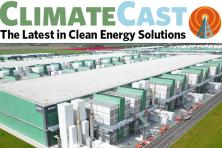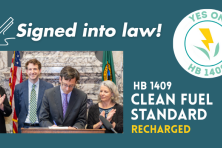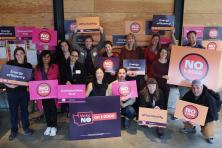During our Climate Leaders Live discussion on the Inflation Reduction Act (Aug, 18, 2022), we responded to a number of attendee questions in written form, because there were just too many good questions to get to in the time we had! Questions answered live can be found in the webinar recording. Here are the additional questions:
Could the panel speak to the provisions in the IRA and CHIPS Act that increase US manufacturing to reduce dependency on foreign supply chains, namely China, which increases US national security and on-shores manufacturing jobs. What are requirements for EV cars being assembled in US? How will this affect availability of these cars?
The electric vehicle incentives as part of the Inflation Reduction Act had two main goals: make electric vehicles more affordable while freezing China out of the supply chain. The components used in EV batteries must not have been “extracted, processed, or recycled by a foreign entity of concern,” which includes China and Russia. The bill requires that by 2024 at least 50 percent of the components in an electric car battery come from the United States, Canada or Mexico. The percentage rises to 100 percent in 2028. And the share of the minerals in batteries that have to come from the United States or a trade ally will climb to 80 percent in 2026. Read more in the New York Times and Supply Chain Dive and Resources.
When do most of the tax credits begin? Is there increased funding for energy conservation, like insulating homes of people?
IRA provides credits for taxable years beginning after December 31, 2022. (Electric vehicles, a big focus, start in 2023.) Some tax credits begin earlier: The “residential clean energy credit” extends and enhances an existing tax break. Costs incurred from the beginning of 2022 to the end of 2032 would qualify for a 30% tax credit. The credit would fall to 26% in 2033 and 22% in 2034. Read more in CNBC and find specific EV models in Electrek and the Department of Energy.
What are domestic content requirements? Will this help women and children get more affordable daycare, etc.?
Most of these provisions were cut and not carried from the Build Back Better bill framework to the Inflation Reduction Act. The Democrats’ ambitious plans at points included universal pre-kindergarten, lower child care costs, paid family and sick leave and the enhanced child tax credit, among other provisions, but those were ultimately eliminated during negotiations. Those cuts became the ninth time in just two and a half years where proposed legislation aimed at helping women and families have been removed, according to a CNN analysis of data from the Congressional Budget Office and Congressional Research Reports. Read more in CNN.
Is there really a carbon savings when you electrify trucks moving heavy loads? (I've heard the footprint for charging such large batteries is big.)
Yes! There is a very urgent need to reduct transportation emissions from heavy duty fleets and there is big movement nationwide to make this happen. Heavy-duty vehicles are the largest contributor to U.S. mobile source nitrogen oxide (NOx) pollution and they also emit harmful fine particulate matter (PM2.5) pollution that disproportionately impacts BIPOC communities.
And we're already doing this work in Washington and Oregon. Last November both Washington and Oregon moved towards a more just and equitable transportation future that prioritizes cleaner air and a healthier climate by adopting the Advanced Clean Truck rule. The ACT Rule requires truck makers to sell an increasing number of clean, zero-emission medium- and heavy-duty vehicles. Washington also adopted the ZEV Program, which directs light duty vehicle manufacturers to increasingly sell zero emission vehicles in Washington and starting in 2024, will result in zero emission vehicles making up 8 percent of all light duty vehicle sales. All West Coast states now have regulations in place requiring the sale of clean, zero-emission light-, medium- and heavy-duty vehicles. Nearly 20 states and jurisdictions have signed on to an action plan striving for 100% electric medium and heavy-duty vehicle sales by 2050. Read more in Utility Dive.
In addition, it is important to note that charging vehicle batteries only has a carbon "footprint" if the electrical grid is powered by fossil fuels. That's why it's important to transform our electrical grids to 100% clean energy—as Washington and several other states have set timetables for doing already.
Understand that Sen. Sinema got $4 billion for drought mitigation in AZ, was that to pay farmers to fallow crop production land, or exactly what? For AZ and other states impacted by the SW drought in the 7 states.
The Colorado, which supplies water to 40 million people in the United States and Mexico and supports billions of dollars of agricultural production across the region, is in the throes of two decades of drought made worse by climate change. At the river’s two immense reservoirs, Lake Mead and Lake Powell, water levels are at just 28 percent of total capacity because of the river’s diminished flow and increased demand.
Southwest lawmakers struck the deal in the 11th hour with hopes that it could buy the fragile Colorado River Basin more time amid its most intense drought in centuries. Administered by the U.S. Bureau of Reclamation over the next four years, the funds would go toward grants, contracts or financial assistance that intend to mitigate drought via voluntary reduced water use and diversions, water conservation projects, environmental efforts, and ecosystem and habitat restoration projects in drought-impacted river basins or inland water bodies, like the Salton Sea in California. Read more in the New York Times, Irrigation Today, and CNN.
Are you able to provide a one page overview of what was in the bill?
We liked this nice summary in the New York Times and Wharton Business School's early assessment of economics and inflation.
How does this, or does this have any implications for Just Transitions for fossil fuel jobs to more Climate friendly occupations? I heard apprenticeships for those getting new careers, but does this also account for those working the fossil fuel industry at this time and giving them adequate incentives for changing?
The bill has strong labor standards, with many projected jobs in growing sectors like clean energy, clean manufacturing, and efficient buildings that will offer workers good wages and benefits. A new analysis commissioned by the BlueGreen Alliance from the Political Economy Research Institute (PERI) at the University of Massachusetts Amherst finds that the more than 100 climate, energy, and environmental investments in the Inflation Reduction Act will create more than 9 million good jobs over the next decade—an average of nearly 1 million jobs each year. 1.2 That includes more than 6 million jobs created over the next 10 years by grants, loans, and tax credits and nearly 3 million jobs stimulated by new loan guarantee authority for the U.S. Department of Energy. Read more from the BlueGreen Alliance.
Can you talk about the disposal issues for batteries re: a great increase in electric vehicles, etc. What research has been done, or needs yet to be done? Are there funds for handling of this very real issue?
Lithium-ion batteries already power phones, laptops, scooters, e-bikes and toothbrushes and global battery manufacturing is growing rapidly to serve the new demand for electric cars, which hit a record 8.6 percent of global new car sales in 2021. There is currently money and R&D going towards battery recycling, but the sector will most certainly need to grow and develop to meet the need. Read more in Canary Media and Electrek.
Is there anything that can be done through Executive Action to improve upon the environmental justice shortfalls of the IRA?
Our panelists answered this question live in the recording, but we've updated with some information reported after our Aug 18 webinar.
The Biden administration is exploring and on track to deploy a series of executive action measures, including new regulations on emissions from vehicle tailpipes, power plants and oil and gas wells. President Biden is coming under pressure to take executive action by environmental groups, including those that criticized the new law as insufficient for the scope of the climate challenge and rebuked Democrats for agreeing to concessions on fossil fuel projects. The move toward executive action comes less than two months after the Supreme Court limited the Environmental Protection Agency’s ability to regulate carbon emissions from power plants. Read more in the New York Times.



